Although I know the research clearly states that how you structure your classroom physically, and how much time you put in up front establishing and rehearsing routines, creating a safe and inclusive climate, and just generally setting the state for a successful school year is directly correlated to how successful, in fact, that academic year will be. And yet, overwhelmed with the sheer quantity of curriculum expectations I had to cover, last year I once again moved too quickly into the math, without fully "training" the students on appropriate classroom interactions. The results were clear: In the classes where I had spent more time up front building climate and establishing routines, students were more successful, generally, in math, whereas the classes with whom I did not spent as much time tone-setting quickly became behavioural nightmares, which ultimately translated into less effective math teaching.
This year I have 5 classes of math and 2 classes of health to teach. In total, I will see 6 different groups of students. Here are a few of the things I have done and will do to manage my classroom effectively...
Seating
The more I read and hear about 21 century learning, the more convinced I am that physical plant can help or hinder student learning. Even with a limited budget (i.e. none), there are things that can be done to foster collaboration, communication and inquiry: After watching colleagues begin last year with a circle, and observing how effectively my VP lead a circle in my own classroom later in the year while working on some restorative practices with my students after a behavioural incident with one particular student affected the whole class, I decided to give the circle a try myself this year.
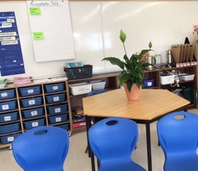
Flexible Groupings
Speaking of practising, another thing I practise is how to choose a partner. We rehearse asking someone to work with you. We also practise how to graciously decline (for example, if you already have committed to working with someone else) so that people's feelings aren't hurt.
I also structure things so that there are some "random" and "forced" groupings: At the beginning of the year, I assign every student in every class a letter: A-B-C-D. This allows me to create four larger teams of 6-7 if needed ("all the As in this corner, all the Bs in that corner", etc.) or 6-7 groups of four ("Find a group of four: You must have one A, one B, one C and one person D in your group").
In addition to assigning letters, I provide each student with a notebook. The notebooks come in four colours: Pink, blue, yellow, green. This allows me to partner in yet another way: "Find someone with a different colour notebook than you, and ask them if... " or, "Find three people with the same notebook colour as you, and together... "
Later in the year, I have students develop "seasons partners" -- they choose four people in the class, one for each season, and write their name in that part of the card (the partner also writes the name on her card). Then I can say, "today you are going to work with your spring partner to...", etc.
In the real world, one has to work with a variety of people. Some we like, some we prefer not to work with, but we still have to. Learning to work respectfully with different people is critical to life success. Surprisingly, it also opens up new and exciting possibilities for friendship. It is with these realities in mind that I structure groupings in my classroom.
Class Rules/Norms
In a classroom like the one described above, it doesn't make sense to have a set of teacher-imposed rules. Especially in the intermediate classroom. But without the luxury of seeing one or two groups of kids for longer periods of time, there has to be some sort of pre-established framework. (I find that on full rotary, there simply isn't the time to foster classroom norms from scratch with each group of students!)
That's why I'm heading back to the Tribes framework this year. In my class, I've posted the four agreements:
- attentive listening
- mutual respect
- appreciation/no put downs
- the right to pass
My plan is to introduce these briefly on the first days with each of my classes, then delve into more detail as the year progresses, tying things like learning skills and norms of accountable talk in with the tribes norms, so that students can see how they are related.
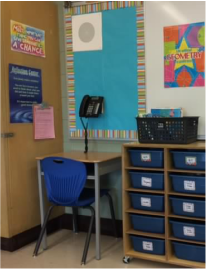
But in general, I am hopeful that establishing a collaborative classroom through the use of a circle and open dialogue can help to foster a classroom climate based on the four agreements. I'll have to be sure I am consistently enforcing and referring back to them; consistently enforcing a long list of rules is something I've never been good at, and I am hoping that Tribes will work better for me than the more traditional "classroom rules".
There has been a movement in recent years of moving away from having a teacher desk in the room, and certainly, I agree that the teacher's work area should not take up prime real estate in a classroom. Nevertheless, with two kids, a dog and no office at home, I need my desk!
When I taught a single class, I used to have a desktop file with folders for each day of the week. Copies of handouts and lessons were carefully organized here once a week. I also had a giant "dayplan" binder, with one page for each day of the cycle.
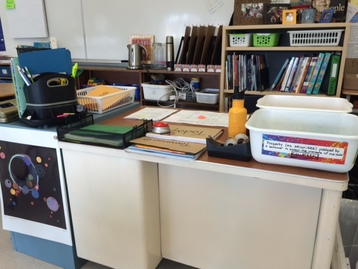
Now that's not practical anymore: First of all, I teach several classes the same thing, so why copy out the same plan over and over? Secondly, I'm hoping increasingly to move to digital format in an effort to reduce paper and be able to access more student work at the click of a mouse -- although this will be a transitional year for me and my classes as I familiarize myself with new formats for tracking work and planning lessons, one has to start somewhere!
Finally, I have two bins on my desk: "collateral", where students can leave me their devices, wallets, expensive jewelry or a shoe if they want to borrow a pencil or a set of headphones, and "out" where students can pick up missed work or letters if they have been away (it remains to be seen to what extent this can be replaced by posting things online in Edmodo).
Behind my desk are 6 labeled magazine racks with a clipboard in each, one for every class I will see.
We shall see what transpires once the students actually arrive, and the system goes "live"!
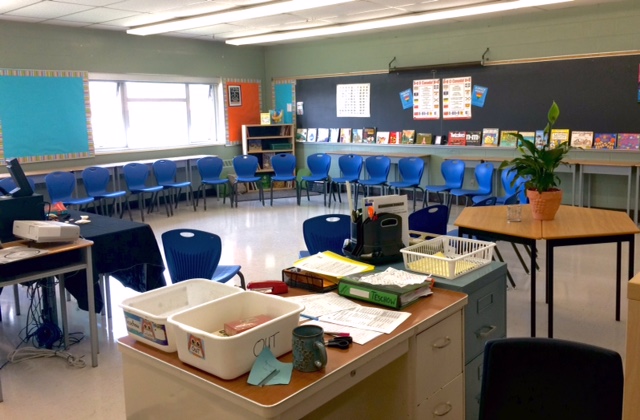
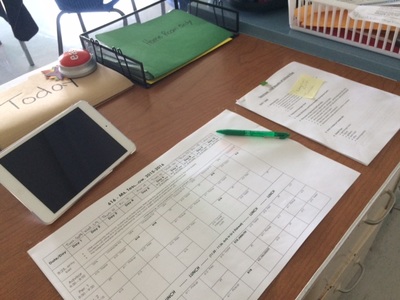
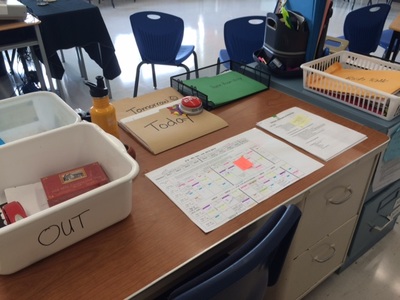
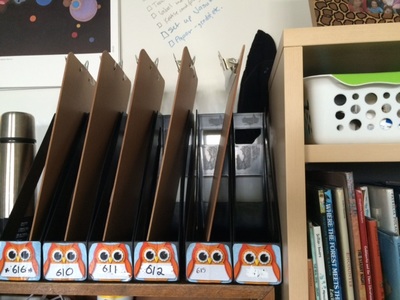
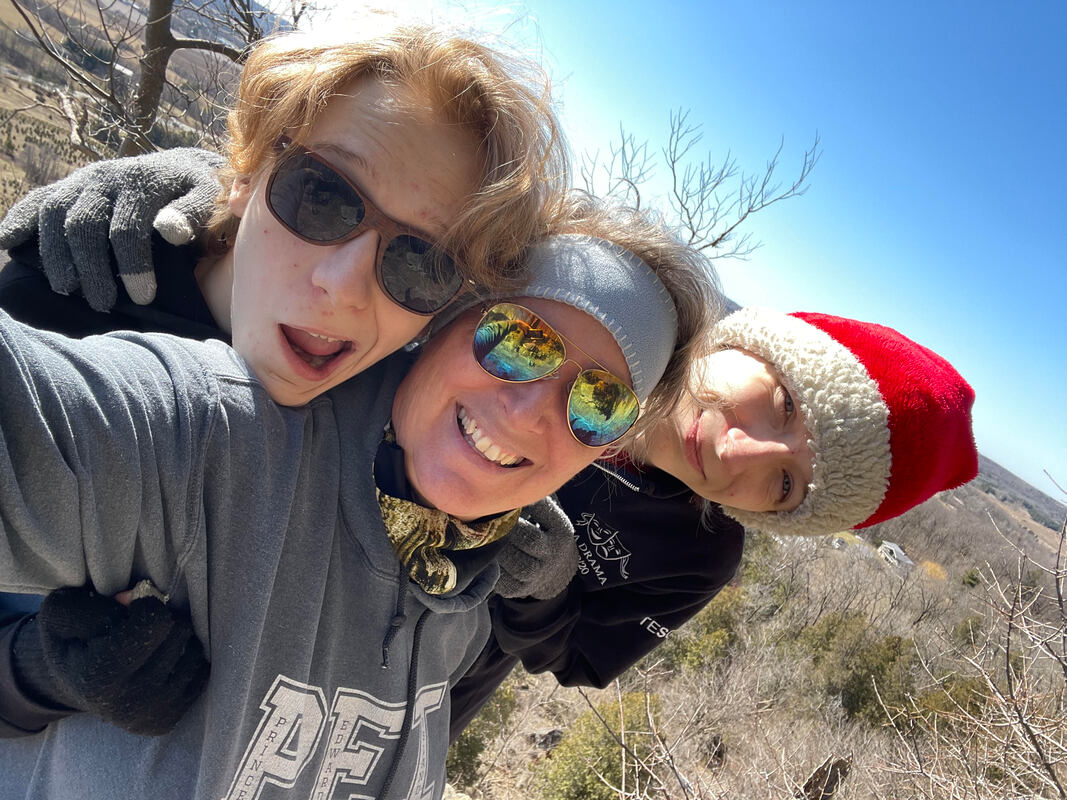

 RSS Feed
RSS Feed